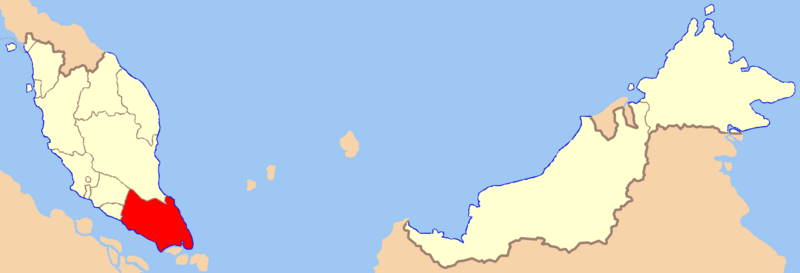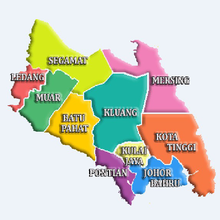 |
(Flag) |
Johor is a Malaysian state, located in the southern portion of Peninsular Malaysia. It is one of the most developed states in Malaysia. The state capital city and royal city of Johor is Johor Bahru, formerly known as Tanjung Puteri (Malay for Princess' Cape). The old state capital is Johor Lama.
Johor is surrounded by Pahang to the north, Malacca and Negeri Sembilan to the northwest, and the Straits of Johor to the south which separates Johor and the Republic of Singapore.
Johor is also known by its Arabic honorific, Darul Ta'zim, or "Abode of Dignity", and as Johore in English.
 |
| Maps oF Malaysia |
 |
| Coats Of Arm |
 |
District of Johor |
Culture
The culture of Johor is influenced by visitors and traders throughout history. A major influence was the Bugis – who first set foot in Malaysia in Johor before continuing on to Melaka, Linggi, Selangor, Pahang and Terengganu – Javanese and the Arabs. They had a powerful impact on the politics of Johor, Pahang, Terengganu and Selangor. The strong Arab influence is apparent in art performances like Zapin and Hamdolok, musical instruments like gambus. Other visible legacies in Johor Bahru are the Arabic names of places such as Wadi Hana and Wadi Hassan in areas populated by the Arab community from Hadhramaut in the southeast of Yemen. Wadi means valley in Arabic.
Language
The Johorean' s Malay, also known as Johor-Riau Malay and originally spoken in Johor, Riau, Malacca and Singapore, has been adopted as the basis for both the Malaysian and Indonesian national languages, Malay and Indonesian, respectively. Due to Johor's location at the confluence of trade routes within Maritime Southeast Asia, as well as the former economic might and influence of Malacca and Johor, the dialect spread as the region's lingua franca since the 15th century; hence the adoption of the dialect as the basis for the national languages.
Clothing
Cekak Musang and Teluk Belanga are types of collar design for the male garment 'baju melayu'. It is said that Teluk Belanga was designed by Sultan Abu Bakar in 1866 to commemorate the shift of Johor's capital from Teluk Belanga to Johor Bahru. The Teluk Belanga design is a simple hemmed round collar with a stiff stitching called 'tulang belut' or 'eel's spine', with a loop at the end to fit a 'kancing'. This collar design creates an exposed neck in contrast to the neck-covering Cekak Musang design that is a raised stiff collar of about 1–2 cm with an opening down to the chest. The collar ends have matching holes to fit buttons.
1.
Kurung Johor
2. Kurung Riau
3. Belah kebaya panjang

No comments:
Post a Comment